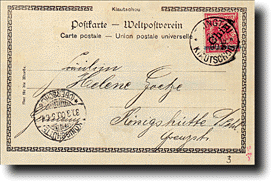The little difference
 Have a look at what changing the postal rates led in German occupied China.
Have a look at what changing the postal rates led in German occupied China.
In 1900, there was a sudden and urgent need for five pfennig stamps in the German tenant area of Kiatshu (China). The reason for that was a tariff change. There were still plenty of ten pfennig stamps, so the solution was obvious: to put on a “5 Pfg.” (later “5 Pf.”) imprint. Because the imprint had to be put on 100-double sheets, and the printing form of the imprint consisted of only 50 plates, each sheet had to go through the press twice. It appeared that there were some copies of which the imprint was barely readable; it remained hidden by the original, diagonal imprint “China”. Therefore, the “failed” copies got the number “5” with a hand-stamp. Originally, this was done with a small “5”, later on, a larger type was used.
A postcard with a ten pfennig stamp which was overprinted three times and the hand-stamp “5” will be auctioned by the end of January 2002 by Heinrich Köhler in Wiesbaden (Germany). The slight difference is that the hand-stamp imprint is of the first (small) type. A promising thing, because it is the rarest of all stamps which are featured with a capital number in the German Michel catalogue.
Not so long ago, the annual Wohlfahrtsmarken were issued in Germany, excess postage stamps, dedicated this time to the theme of “the movie”. The German stamp magazine Deutsche Briefmarken-Zeitung announces that the perforation of the booklet stamps will deviate from that which was used for the ten-stamp sheets. The booklet stamps have perforation 13.5:13.25, the stamps from the sheet have perforation 14.25.
More info:
Maandblad Filatelie
Credits:
|
|
